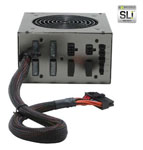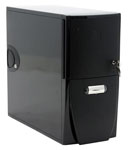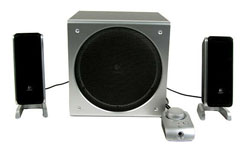Mid-Range Buyer's Guide, September 2005
by Jarred Walton on September 19, 2005 12:05 AM EST- Posted in
- Guides
Remaining Recommendations
We've covered the major components of the systems, and all that remains are the accessories. There isn't much new to say on the majority of these parts, and our Price Guides cover each area in more detail. Here are the rest of the components, and for most of them personal preference will play a large part in determining what you get. If you want higher quality speakers, you'll need to spend more money. A faster hard drive (or multiple hard drives) is definitely an option, but for most people it won't have a major impact - we generally prefer storage capacity and low noise levels over a small increase in HDD performance. Case, power supply, and optical storage choices round out the final components.
We have two lists of the remaining parts, one for the gaming configurations and the other for the office setups. We tried to balance the final system cost as much as possible, but the simple truth is that a good gaming/enthusiast setup requires more expensive parts than a business configuration. You can always downgrade some of the components to cheaper alternatives, but if we were building a computer for our own use, we'd rather save up for better quality than settle for lower cost.
Gaming Components:
Office Components:
Most of the choices should be pretty self-explanatory, so we just want to touch on the important areas. First, we've chosen to use a higher end power supply for the gaming configuration. Many people think that the modular power supplies are nice as they help to eliminate cable clutter, though some of the cables are a little stiff and can be difficult to route. The SunBeam 550W that we've chosen includes two PCIe power connectors, which would be required for an SLI configuration. (If you're running high-end components in an SLI setup, we'd think twice about using simple molex-to-PCIe adapters.) $86 for a power supply is a lot of money, but that's better than having random system crashes caused by exceeding the PSU load levels. Antec, OCZ, Enermax, and a few others also have some SLI-ready power supplies, though most cost upwards of $100 (and we'd avoid anything claiming SLI readiness that costs under $75).
Both setups use pretty low-end speaker arrangements. The Z-3e speakers sound good for the price, but they're not at the level of something like the Z-5500 or Klipsch, and true audiophiles would scoff at either of those "high end" choices that we just mentioned. If you're serious about audio quality, you probably already know more than what we typically cover in the Buyer's Guides. (The entire Logitech line of speakers is pretty reasonable if you're looking for other options. We've recommended them many times in the past, and this isn't really a change in recommendation so much as an alternative that you might consider.) We also stick with the integrated audio solutions for all of the systems, though the Karajan adapter of the DFI board certainly offers the best overall quality of the four boards. While there is a difference between integrated audio and discrete audio solutions, you'll need better speakers before it really begins to matter.
Our hard drive and optical drive selections are essentially a toss up. Our last Hard Drive Roundup showed that SATA 3.0Gbps drives were faster in some areas, NCQ could help out in certain tests as well, but there was no clear victor. All things being equal, we'll go for cost per GB, and for the dual-core systems, we'll also grab an NCQ enabled drive. Some people would rather have a better warranty like the 5-year Seagate and Western Digital Raptor or Caviar RE. If you ever need to use that warranty, though, you'll probably be pretty unhappy - the data on the drive is almost always more important than the drive itself. That's why a good backup strategy is important, and the DVDR drives that we've listed will get you started. We should also mention that firmware updates to the NEC 3540A and BenQ DW1640 drives have ironed out most of the media compatibility issues, so either drive is a good purchase.
We've covered the major components of the systems, and all that remains are the accessories. There isn't much new to say on the majority of these parts, and our Price Guides cover each area in more detail. Here are the rest of the components, and for most of them personal preference will play a large part in determining what you get. If you want higher quality speakers, you'll need to spend more money. A faster hard drive (or multiple hard drives) is definitely an option, but for most people it won't have a major impact - we generally prefer storage capacity and low noise levels over a small increase in HDD performance. Case, power supply, and optical storage choices round out the final components.
We have two lists of the remaining parts, one for the gaming configurations and the other for the office setups. We tried to balance the final system cost as much as possible, but the simple truth is that a good gaming/enthusiast setup requires more expensive parts than a business configuration. You can always downgrade some of the components to cheaper alternatives, but if we were building a computer for our own use, we'd rather save up for better quality than settle for lower cost.
 |
 |
 |
| Click images to enlarge. | ||
Gaming Components:
| Hard Drive: | Western Digital SATA II 160GB 7200RPM 8MB Caviar SE | $81 |
| Optical Drive: | BenQ DW1640 Black (OEM) | $43 |
| Case: | Cooler Master Cavalier 3 CAV-T03-UK | $76 |
| Power Supply: | SunBeam 550W NUUO SUNNU550-US-BK Modular PSU | $86 |
| Speakers: | Labtec ARENA 685 5.1 Speakers | $48 |
| Keyboard and Mouse: | Logitech Internet Pro Desktop | $23 |
 |
 |
 |
| Click images to enlarge. | ||
Office Components:
| Hard Drive: | Hitachi SATA 250GB 7200RPM 8MB Deskstar 7K250 NCQ | $120 |
| Optical Drive: | NEC 3540A Black (OEM) | $42 |
| Case and Power Supply: | Antec Sonata II + SmartPower 2.0 450W PSU | $115 |
| Speakers: | Logitech Z-3e 2.1 Speakers | $73 |
| Keyboard and Mouse: | Logitech Internet Pro Desktop | $23 |
Most of the choices should be pretty self-explanatory, so we just want to touch on the important areas. First, we've chosen to use a higher end power supply for the gaming configuration. Many people think that the modular power supplies are nice as they help to eliminate cable clutter, though some of the cables are a little stiff and can be difficult to route. The SunBeam 550W that we've chosen includes two PCIe power connectors, which would be required for an SLI configuration. (If you're running high-end components in an SLI setup, we'd think twice about using simple molex-to-PCIe adapters.) $86 for a power supply is a lot of money, but that's better than having random system crashes caused by exceeding the PSU load levels. Antec, OCZ, Enermax, and a few others also have some SLI-ready power supplies, though most cost upwards of $100 (and we'd avoid anything claiming SLI readiness that costs under $75).
Both setups use pretty low-end speaker arrangements. The Z-3e speakers sound good for the price, but they're not at the level of something like the Z-5500 or Klipsch, and true audiophiles would scoff at either of those "high end" choices that we just mentioned. If you're serious about audio quality, you probably already know more than what we typically cover in the Buyer's Guides. (The entire Logitech line of speakers is pretty reasonable if you're looking for other options. We've recommended them many times in the past, and this isn't really a change in recommendation so much as an alternative that you might consider.) We also stick with the integrated audio solutions for all of the systems, though the Karajan adapter of the DFI board certainly offers the best overall quality of the four boards. While there is a difference between integrated audio and discrete audio solutions, you'll need better speakers before it really begins to matter.
Our hard drive and optical drive selections are essentially a toss up. Our last Hard Drive Roundup showed that SATA 3.0Gbps drives were faster in some areas, NCQ could help out in certain tests as well, but there was no clear victor. All things being equal, we'll go for cost per GB, and for the dual-core systems, we'll also grab an NCQ enabled drive. Some people would rather have a better warranty like the 5-year Seagate and Western Digital Raptor or Caviar RE. If you ever need to use that warranty, though, you'll probably be pretty unhappy - the data on the drive is almost always more important than the drive itself. That's why a good backup strategy is important, and the DVDR drives that we've listed will get you started. We should also mention that firmware updates to the NEC 3540A and BenQ DW1640 drives have ironed out most of the media compatibility issues, so either drive is a good purchase.










56 Comments
View All Comments
vailr - Monday, September 19, 2005 - link
No mention of the nForce4 SLI Intel Edition chipset?And note that, it apparently:
"DOES NOT support the dual-core Pentium D 820 processor"
"The 820 does not work with Nforce boards, you have to get an 830."
See:
http://forums.anandtech.com/messageview.aspx?catid...">http://forums.anandtech.com/messageview...amp;thre...
Also, maybe a mention of HD sound level quietness?
Samsung HD's appear to be the quietest, followed by Seagate as next quietest? Or: have newer drives from Hitachi, WD or Maxtor changed that idea?
JarredWalton - Monday, September 19, 2005 - link
I've got one of the newer WD drives, and the fan noise overpowers anything from the HDD. Maxtors are still pretty loud, IMO, but mostly on seek noise. Thankfully, all of the HDDs are quiet on the bearing noise front. The older IDE drives from several companies were really bad. FDB has cleared up those problems.noxipoo - Monday, September 19, 2005 - link
I thought midrange was... well mid priced as well. i've only been out of the country for 2 weeks, did something new come out that i'm not aware of?JarredWalton - Monday, September 19, 2005 - link
Read it in the context of the article. Basically, if you're going to spend $1250 (give or take) on a computer, but games are really important to you, I'm recommending that you downgrade most other parts in order to get the 7800GT. A fast GPU is the most important item in a gaming system, in my opinion.yacoub - Monday, September 19, 2005 - link
While there is a difference between integrated audio and discrete audio solutions, you'll need better speakers before it really begins to matter.Well there is also the 3D gaming performance difference, where the on-board solutions tend to suck up CPU resources something awful when compared to a peripheral card audio solution.
yacoub - Monday, September 19, 2005 - link
$1250 is the right goal for pricing for a Mid-Range system. You can build a solid system for that amount that will run the latest games fine and offer plenty of performance for everything else. Good call on that price range (within $250 either way makes sense, but under $1350 is ideal).archcommus - Monday, September 19, 2005 - link
I don't know what this world is coming to when the recommended MID-RANGE video card is almost a frickin' four hundred dollars. How is the slightly lesser version of the most recent model of video card considered mid-range and not high end? I'd call that high end, with the top-level 7800 being ultra high-end.yacoub - Monday, September 19, 2005 - link
One word: Marketing.That's the only reason companies have the balls to debut a new GPU at anything over $350 - they can convince people it's omg amazingly necessary and better.
JarredWalton - Monday, September 19, 2005 - link
The $400 video card is for gaming. For games, that fast video card is a LOT more important than getting a faster CPU. $370 for the X2 3800+ or $370 for the 7800GT? How dare they charge that much money!? For the record, I remember a time when Pentium MMX 200 processors cost $650, as did the K6 200MHz. Sure, graphics card prices have gone up, but so has the importance of the GPU relative to the rest of the system - again, for games only.yacoub - Tuesday, September 20, 2005 - link
Like I said, marketing. Good to see it's working, too. That'll keep them encouraged to keep upping the new card debut prices every six months since they can find suckers to buy them at those prices. Eventually I'll just move to console gaming while some of you take out loans for overpriced PC hardware. (And this is coming from a PC gaming fanatic who dislikes most current console offerings - yes, I will be that certain of not wasting money that I will sacrifice the latest PC gaming simply to avoid being price raped.)I've never paid $400 before yet have always been able to buy a new GPU that runs the top games at high enough res smoothly. In fact the most I've ever paid for a hot new GPU was $300. I'm currently ready to upgrade from my 9800 Pro 128mb and will go with something again around $300 which will play all the current games just fine - and I'm not even playing BF2 or FEAR so it's even easier for me to 'make due' with an X800XL or similar card.